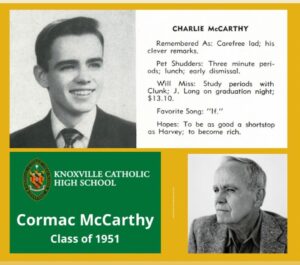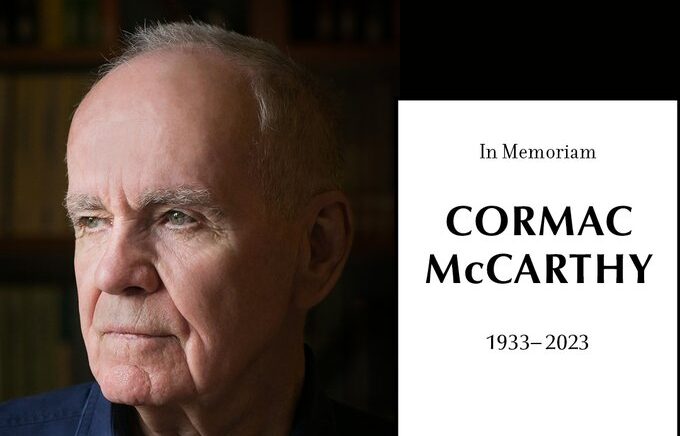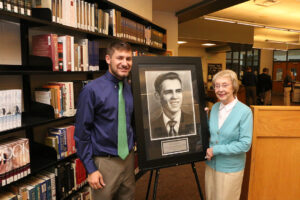By The East Tennessee Catholic
Cormac McCarthy, a Pulitzer Prize-winning novelist and Knoxville native who graduated from Knoxville Catholic High School in 1951, died June 13. He was 89.
Mr. McCarthy passed away of natural causes at his residence in Santa Fe, N.M., where he has called home for decades, according to his publisher, Alfred A. Knopf.
Although Mr. McCarthy was born in Rhode Island on July 20, 1933, he grew up in Knoxville as one of six children in an Irish Catholic family that relocated to East Tennessee when Mr. McCarthy’s father began working for TVA as a lawyer.
 Mr. McCarthy was widely acclaimed in national literary circles as one of the greatest contemporary American writers because of the breadth of his work, which includes 12 novels, two plays, five screenplays, and three short stories.
Mr. McCarthy was widely acclaimed in national literary circles as one of the greatest contemporary American writers because of the breadth of his work, which includes 12 novels, two plays, five screenplays, and three short stories.
He received the Pulitzer Prize for fiction in 2007 for “The Road,” a postapocalyptic story of survival. “The Road” also earned the James Tait Black Memorial Prize for fiction. He received the National Book Award and the National Book Critics Circle Award for his 1992 bestselling book “All the Pretty Horses,” which was made into a major motion picture in 2000 that starred Matt Damon and Penélope Cruz and was directed by Billy Bob Thornton.
“All the Pretty Horses” was the first of Mr. McCarthy’s Border Trilogy novels, which incorporated striking imagery to depict life in the Southwest, where he relocated in 1976. The other works in the trilogy are “The Crossing” in 1994 and “Cities of the Plain” in 1998. His 2005 novel “No Country for Old Men” also was made into a major motion picture in 2007 starring Tommy Lee Jones, Javier Bardem, Josh Brolin, and Woody Harrelson. The film was a commercial success and earned four Academy Awards.
His other books include “The Passenger,” “Stella Maris,” and “Blood Meridian,” which many in the literary community consider his best work, with some calling it the great American novel.
Mr. McCarthy attended St. Mary School in downtown Knoxville and Knoxville Catholic High School on Magnolia Avenue. He also was an altar boy at Immaculate Conception Church. He began attending the University of Tennessee in 1951, where he studied physics and engineering, but he began pursuing an interest in writing at the same time.
He dropped out of UT in 1953 to join the Air Force but returned to UT in 1957, where he published two stories—“Wake for Susan” and “A Drowning Incident”—in the student literary magazine “The Phoenix.” He earned creative writing awards for his work, and in 1959 he dropped out of college for the final time.
He left East Tennessee at this juncture and spent the next few years traveling the United States and Europe.
Publisher Random House printed Mr. McCarthy’s first novel, “The Orchard Keeper,” in 1965, and it won a 1966 William Faulkner Foundation Award for notable first novel. He wrote his second novel, “Outer Dark,” in 1968.
 Mr. McCarthy returned to the Knoxville area in 1969, and he wrote his next book, “Child of God,” in 1973. Like “Outer Dark,” “Child of God” was set in southern Appalachia and explored dark themes. He then relocated to El Paso, Texas, in 1976.
Mr. McCarthy returned to the Knoxville area in 1969, and he wrote his next book, “Child of God,” in 1973. Like “Outer Dark,” “Child of God” was set in southern Appalachia and explored dark themes. He then relocated to El Paso, Texas, in 1976.
In 1979, Mr. McCarthy published the semiautobiographical “Suttree,” which he had written 20 years before. The book was based on his experiences along the Tennessee River in Knoxville.
Much of Mr. McCarthy’s work was defined as “bleak and violent,” highlighting the brokenness and ruthlessness pervasive in the life of his characters. His writing style defied traditional literary norms, such as his sparing use of punctuation, which he rejected as extraneous. But his use of language was highly praised, and he was often compared to renowned American author William Faulkner.
Mr. McCarthy was considered reclusive throughout his adult life, and he was known earlier in his career as having an extremely spartan lifestyle as he honed his craft.
Knoxville Catholic High School released this statement shortly after news of Mr. McCarthy’s death was reported:
“We are saddened to learn of the passing of one of our own, Pulitzer Prize-winning novelist Cormac McCarthy ’51. Eternal rest grant unto him, O Lord, and let perpetual light shine upon him. May his soul and all the souls of the faithful departed, through the mercy of God, rest in peace. Amen.”
 Known as Charlie McCarthy when he was in school, the KCHS annual included this entry while he attended there:
Known as Charlie McCarthy when he was in school, the KCHS annual included this entry while he attended there:
“Remembered As: Carefree lad; his clever remarks.”
“Pet Shudders: Three-minute periods; lunch; early dismissal.”
“Will Miss: Study periods with Clunk; J. Long on graduation night; $13.10.”
“Favorite Song: ‘If.’
“Hopes: To be as good a shortstop as Harvey; to become rich.”
He is said to have changed his name from Charlie to Cormac for his writing career to avoid any confusion with ventriloquist Edgar Bergen’s prop Charlie McCarthy. Cormac was a McCarthy family nickname given to his father.
In 2014, KCHS recognized Mr. McCarthy with a charcoal drawing of the author as he appeared in his senior picture. The school also unveiled a plaque honoring the writer for his literary accomplishments.
KCHS students formed a Cormac McCarthy Club that focuses on literary interests and the works of Mr. McCarthy.
The plaque reads:
In honor of KCHS alumnus
Charles “Cormac” McCarthy
Class of 1951
Novelist, screenwriter, playwright. One of the greatest authors in the history of American literature. May his genius and his legacy inspire us to pursue excellence whilst living humbly and deliberately.
To know what will come is the same as to make it so.
–Suttree, 1979
Cormac McCarthy Club 2010-2011 Artwork by Eric Theodore ’11
At the time, among those on hand for the portrait unveiling was Carolyn Sue (Wright) Huber, who also was in the class of 1951. Mrs. Huber, who was an All Saints Church member when she passed away in 2018, said at the time that she was in school with Mr. McCarthy for most of the 12 years they attended St. Mary School at Immaculate Conception Church and KCHS in the 1940s and early ’50s. She described him as a “delightful person.”
“Everybody liked Charlie. He was a nice, polite gentleman who liked to daydream, but he was always listening so he would have something to write about. He was very bright,” she said.
She had last seen him years ago at a reunion of classmates at her Knoxville home.
“We missed him and we were sorry he couldn’t be here, but we understand with all his commitments,” she said then.
Mr. McCarthy was married to Jennifer Winkley from 1997-2006, Annie DeLisle from 1967-81, and Lee Holleman from 1961-62. He has two children, Cullen McCarthy and John McCarthy.
Sources for this story included The East Tennessee Catholic archives, CormacMcCarthy.com, Alfred A. Knopf @AAKnopf, Wikipedia, Knoxville Catholic High School.


